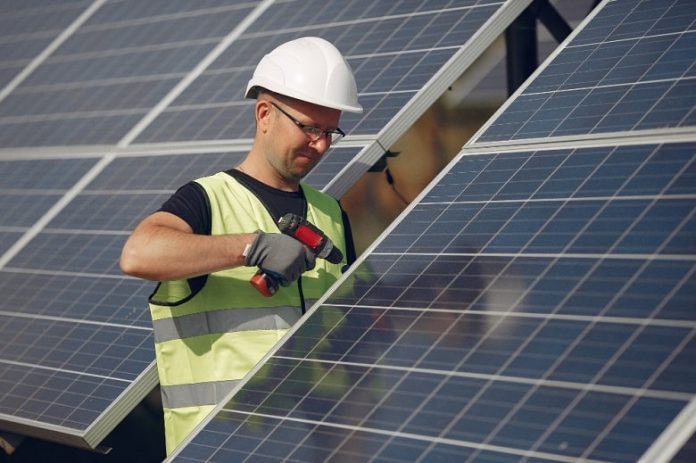Even with occasional maintenance checks, solar panel systems can endure for years. Although having a little knowledge about solar power maintenance may go a long way, considering routine inspections will save expensive repairs in the future and keep your panels looking good. For solar panel system maintenance, it’s also a good idea to be knowledgeable about each solar component.
Given below are five simple steps on ‘How to maintain solar panels?’ which would help you in the maintenance of solar system efficiently:
Steps on how to maintain solar panels
1. Keeping the panels clean
Solar panels do not require frequent cleaning in areas with recurring rainy seasons. Any dust will be eliminated by the sporadic rain or snow, by the fact that it melts more quickly on the panels than on the rest of the roof. But it’s a good idea to check the panels every few months to ensure there aren’t any traces of dirt, dust, or debris. If there is, a quick rinse should solve the issue.
Getting on the roof to clean the panels is not advised. Consider buying a long-handled broom or hose if there has been a significant accumulation of dirt. If there are leaves accumulated, you could want to use a roof rake to solve the issue.
Despite being low-maintenance, solar panels still need to be cleaned frequently to operate at their best. It is advised to have a conversation about maintenance plans that provide consumers with routine solar panel maintenance.
You can still benefit from maintenance plans created to reduce the cost of panel maintenance by providing direct access to equipment warranties if you decide to buy your panels rather than lease them.
2. Use solar monitoring equipment to perform routine inspections
Solar monitoring tracks the system’s electricity output to ensure your solar panels are operating properly. You get round-the-clock assurance that your solar panels are operating as effectively as possible with solar monitoring. Knowing when to perform cleaning and regular maintenance on the panel to improve efficiency is made easier by this.
3. Use professional services
Cleaning solar panels is a straightforward process that you may handle just as well as a pro. If your installation is small, it makes sense to clean it yourself because hiring a professional would cost more than the expected energy savings from clean solar panels.
Additionally, you can request that your solar installer to clean your panels when carrying out standard technical upkeep. They can accomplish this task in total safety.
4. Keep shadows away from solar panels
Utilising the sun’s free energy, solar panels create a clean renewable energy source that effectively and efficiently powers your home. Trees are an excellent method to increase the value of your home and your land because they beautify the area while offering shade in the summer and shelter from the wind in the winter.
However, if they obstruct your panels’ capacity to absorb sunlight, prune them back. Find out if tree trimming is part of the routine maintenance for your solar panels, and if it isn’t, talk to your landscaper about adding it.
Take a step back and carefully inspect your home and solar panels from a distance. There can be additional shade from trees or shade before solar panel installation, which hinders the performance of your solar panels by partially obstructing sunlight. As the amount of shade increases, energy generation declines. Take into account pruning any trees that may have expanded during that time.
Keep track of the daily performance. Take note of the amount of energy produced at specific times of the day, record any cloud cover, or inquire about options for monitoring consumption.
5. Look for rust, ageing, and damage on your solar panels
Note that if you reside in a coastal area, you should do this closer to twice a year. You should inspect your solar panels for rust, weathering, and damage at least once a year. The efficiency of your solar panels may be impacted if you neglect to maintain your solar power system.
Safety measures should also be considered
There are many circumstances in which you may access your solar panels, which may enable you to clean and inspect them easily. If going onto the roof is necessary, make sure your top priority is safety. Have all the appropriate safety gear close at hand, keep an eye out for any potential dangers on your roof, and, if you’re unsure about the accessibility of your panels, ask a specialist for guidance or assistance.
Apart from these measures, you can also do the following:
Conduct a visual examination for maintaining solar panels
Your solar panels’ ability to perform their function can be hampered by debris such as dirt, dust, sand, grit, animal and bird droppings, tree leaves, and seasonal pollen. You will undoubtedly want to ensure that your solar panels remain as clear and unobstructed as possible because even a minor obtrusion of the surface area of the panels might impair their ability to gather and create effective energy. The best method to ensure this is to regularly visually inspect your panels.
Regular checks (at least once a month) from the ground and a closer vantage point, such as a second-story window, will enable you to stay informed about any debris or damage affecting the performance of your solar panels and make the required service requests.
It will be simpler for the maintenance team to send a repair or maintenance crew with the proper tools to fix the issue if you can describe and detail to them what you perceive is happening with the panels. This would help you keep a check on the life of your solar panel and battery.
Maintenance may be necessary every month or even week, depending on the sort of solar panels you have and where you live. To choose a maintenance schedule that works for you, take into account the manufacturer’s maintenance recommendations as well as the climate where you reside.

